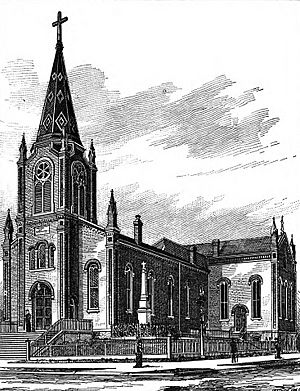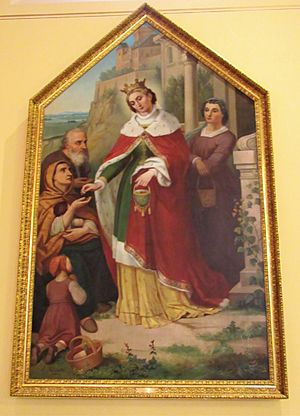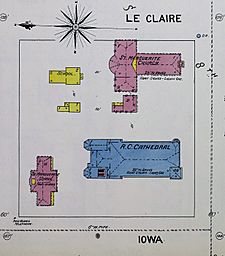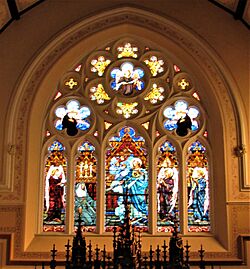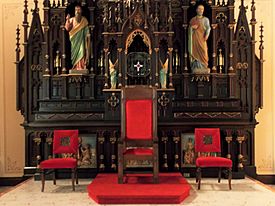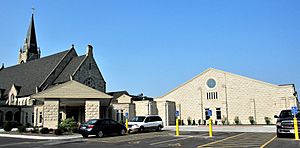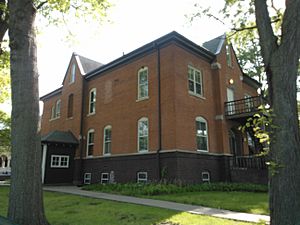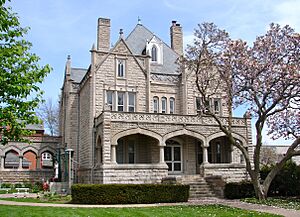Sacred Heart Cathedral (Davenport, Iowa) facts for kids
Quick facts for kids Sacred Heart Cathedral |
|
|---|---|
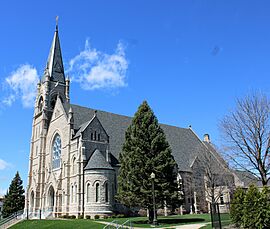
Sacred Heart Cathedral in 2022
|
|
| Location | 422 E. 10th St. Davenport, Iowa |
| Country | United States |
| Denomination | Catholic Church |
| History | |
| Status | Cathedral/parish |
| Founded | 1856 (parish) |
| Dedication | Sacred Heart of Jesus |
| Dedicated | November 15, 1891 |
| Architecture | |
| Functional status | Active |
| Architect(s) | James J. Egan (cathedral) |
| Style | Gothic Revival |
| Groundbreaking | June 1889 |
| Completed | 1891 |
| Specifications | |
| Length | 180 feet (55 m) |
| Width | 80 feet (24 m) |
| Nave width | 65 feet (20 m) |
| Height | 75 feet (23 m) |
| Number of spires | One |
| Spire height | 160 feet (49 m) |
| Materials | Bedford stone |
| Administration | |
| Diocese | Davenport |
Sacred Heart Cathedral is a Catholic cathedral and parish church in Davenport, Iowa, United States. It belongs to the Diocese of Davenport. The cathedral sits on a hill overlooking the Mississippi River. It is listed on the National Register of Historic Places as part of the Sacred Heart Roman Catholic Cathedral Complex. This complex includes the church, the rectory (where priests live), and the former convent (a building for nuns). The cathedral is also near the Cork Hill Historic District, an area settled by Irish immigrants.
Contents
St. Margaret’s Cathedral: The Beginning
The church's story began in 1856. More people were moving to Davenport, so the Dubuque Diocese decided to create a new church on the east side of the city. Antoine and Marguerite LeClaire gave the land and money to build the first church. Before this, people went to St. Anthony's Church downtown.
On June 29, 1856, Bishop Mathias Loras of Dubuque laid the first stone for the church. Antoine LeClaire managed the building work. The church was named St. Margaret (or St. Marguerite) to honor St. Margaret of Scotland and Marguerite LeClaire. It was built with red brick in the Romanesque Revival style. A wooden rectory was built next to it. In 1859, this rectory was moved, and a brick one took its place, also paid for by Antoine LeClaire.
The Rev. Andrew Trevis was the first pastor. In 1857, Rev. Henry Cosgrove joined St. Margaret's and became the pastor in 1861. He stayed with the church for the rest of his life.
During the American Civil War (1861-1865), the Union Army had headquarters in Davenport. Four army camps were within St. Margaret's parish area. This likely affected the church and its pastor. After the war, an addition was made to the church in 1866.
On May 2, 1873, an unknown person set fire to the church. Only the altar was damaged. A new altar was installed later that year with a painting of St. Margaret. This painting is now in the current cathedral. In 1878, robbers tried to steal money from the church but failed. They were later caught and sent to prison.
On May 8, 1881, Pope Leo XIII created the Diocese of Davenport. The Very Rev. John McMullen became the first bishop, and he made St. Margaret's his cathedral. Bishop McMullen celebrated his first Mass there on July 31, 1881. Father Cosgrove became the cathedral's rector.
Bishop McMullen passed away on July 4, 1883. He was buried under the altar of St. Margaret's. On July 11, 1884, Pope Leo XIII chose Father Cosgrove to be the next Bishop of Davenport. He was the first of four pastors from this church to become a bishop.
Sacred Heart Cathedral: A New Beginning
Building a New Cathedral
In 1889, Bishop Cosgrove decided to build a new, larger church. The old church was becoming too small. The church property is in a neighborhood called Cork Hill, where many Irish immigrants lived.
James J. Egan, an architect from Chicago, was chosen to design the new cathedral. He also designed St. Ambrose Church in Des Moines. The design was influenced by the Gothic Revival architecture style, similar to old English churches. Walsh & Edwards of Davenport were the builders.
The cornerstone for the new cathedral was laid on April 27, 1890. The new cathedral was finished in 1891. Bishop Cosgrove dedicated it on November 15, 1891.
Changing the Name
Father Trevis suggested changing the parish's name. He had visited a place in France where St. Margaret Mary Alacoque had visions of the Sacred Heart. This devotion was popular in the parish. Bishop Cosgrove also had a strong devotion to the Sacred Heart.
The bishop asked Pope Leo XIII for permission to name the new church Sacred Heart Cathedral. On December 23, 1889, the pope agreed. He asked that a small chapel dedicated to St. Margaret still be kept in the church. Sacred Heart Cathedral was the first cathedral in the United States to be dedicated to the Sacred Heart.
Cathedral Design and Features
Sacred Heart Cathedral has a main section called a nave and a tall tower at one corner. The building is made of brick covered with Bedford stone. The church is 180 feet (55 m) long. The nave is 65 feet (20 m) wide. The roof is 75 feet (23 m) high, and the spire on the tower is 160 feet (49 m) tall. When it was built, the cathedral was the tallest building in the Quad Cities.
Inside, the church has an open space with no columns. There is a lot of beautiful woodwork, including the altars, pews, and ceiling. The vaulted ceiling is supported by large wooden beams. The stained glass windows are very colorful. The tall windows along the sides show the Twelve Apostles. The large round window at the front has Christian symbols like an anchor for hope and a cross for the crucifixion. The big window above the altar shows Jesus appearing to St. Margaret Mary Alacoque.
Electric lights were first installed in the sanctuary in 1895. In 1907, the cathedral's inside was renovated. This included painting the interior and adding more lights.
20th Century Changes
In the early 1900s, Bishop Cosgrove's health declined. Bishop Davis, who was the cathedral's rector, became the next bishop. He was the first bishop to be consecrated (officially made a bishop) in Sacred Heart Cathedral on November 30, 1904.
On August 20, 1928, Lightning struck the building. This caused smoke and water damage. Services were held in St. Margaret's Chapel during repairs. The church was repainted in a gothic style.
In the 1960s, the parish made changes based on the Second Vatican Council. In March 1964, a new altar was set up so the priest could face the people. Sacred Heart was the first church in the Quad Cities to do this. In 1980, the communion rail and pulpit were removed. A new cathedra (bishop's chair) was placed so the bishop would face the congregation. Services began to be celebrated in English instead of Latin.
The cathedral parish has also focused on helping the community. El Centro Cultural Hispano was started in 1975 to help Spanish-speaking people. Masses in Spanish began in 1977. A clothing center and a food pantry were also started by the parish.
Major renovations happened in the early 1990s, thanks to a generous gift from a parishioner. The roof was replaced, and the inside of the church was repainted. A painting of St. Margaret of Scotland, which had been damaged, was restored and hung in the cathedral.
In the 1990s, Masses in Vietnamese were added for the growing Vietnamese community. A shrine to Our Lady of La Vang was also built on the cathedral grounds in 2004.
21st Century Updates
In 2011, Msgr. Robert Gruss, who was the cathedral's rector, was named the Bishop of Rapid City. He was the third rector/pastor to become a bishop.
Starting in 2012, plans were made to update the church buildings. A new entrance that is easy for people with disabilities to use was finished in 2013. In September 2016, construction began on a new hall behind the cathedral. This hall includes a gathering space, restrooms, and classrooms. It was dedicated on November 19, 2017, and named for Weir and Pat Sears, who gave a large donation. The parking lot was also improved.
A tornado hit Davenport on October 6, 2016, causing some damage to the cathedral and rectory. They were repaired in 2017. The old iron cross on the tower was replaced with a new gold-leafed aluminum cross. A new carillon (a set of bells) was added to the tower. The original bell from 1856 was moved and placed in front of the new hall. In 2019, the stained glass windows were cleaned and repaired.
On July 10, 2025, Rev. Thomas J. Hennen, who had been the pastor since 2021, was named the Bishop of Baker in Oregon. He is the fourth pastor/rector to become a bishop.
Rectory and Convent Buildings
The current rectory, where the priests live, was designed by architect Gustav Hanssen and finished in 1895. It is a 21⁄2-story house built in the Tudor Gothic style. This style matches the cathedral's Gothic Revival look. The outside is made of limestone. An addition with offices and garages was later added to the rectory.
The convent, a building for nuns, was designed by George P. Stauduhar and completed in 1902. It was made of red brick. This two-story building also followed the Gothic and Tudor styles. In 2012, the convent was torn down to make way for the new accessible entrance to the cathedral.
Sacred Heart School History
The parish school started in 1859 in a wooden building that was first used as the rectory. This building was made larger for more classrooms. The Sisters of Charity of the Blessed Virgin Mary began teaching at the school in 1861.
In September 1882, Bishop McMullen started St. Ambrose Seminary and Academy, now St. Ambrose University, using two classrooms at St. Margaret's School. St. Ambrose moved to its current location in 1885.
A high school program for girls was started but lasted only about ten years. Most girls left after a year or two to work. The program was later stopped.
A third school building was built in 1914 for over $100,000. Bishop Davis dedicated it on January 17, 1915. In the 1990s, the parish school joined with St. Alphonsus School to form John Paul Academy. Later, in 2004, Sacred Heart, St. Alphonsus, and Holy Family schools joined to form All Saints School. The former Holy Family School building was used for All Saints. The Sacred Heart School building was used for religious education classes until it was torn down in the summer of 2017.
Pastors and Rectors
These priests have served as pastor of St. Margaret's and Sacred Heart. Since 1881, they have also been the cathedral rector:
- Rev. Andrew Trevis (1856–1861)
- Rev. Henry Cosgrove (1861–1884)
- Rev. Andrew Trevis (1884–1889)
- Rev. James Davis (1889–1906)
- Rev. John Flannagan (1907–1926)
- Msgr. Francis Leonard (1926–1932)
- Msgr. William Shannahan (1932–1937)
- Msgr. Martin Cone (1937–1953)
- Msgr. Thomas Feeney (1953–1968)
- Msgr. Ralph Thompson (1968–1971)
- Msgr. Sebastian Menke (1973–1986)
- Msgr. Marvin Mottet (1986–2005)
- Rev. Robert Busher (2005–2010)
- Msgr. Robert Gruss (2010–2011)
- Rev. Richard Adam (2011–2021)
- Rev. Thomas Hennen (2021–present)
The Pipe Organ
The first pipe organ in the cathedral was moved from St. Margaret's Cathedral. It was a gift from Antoine LeClaire. In September 1895, a new organ was installed.
In 1949, the Kilgen Organ Company installed another new pipe organ. This organ was originally meant for another church, but delays allowed it to be installed in Sacred Heart instead.
The old Kilgen organ was removed in 1991. A new Noack pipe organ was installed. It was first used on January 29, 1992.
The organ is located in the back of the cathedral. Some of its pipes are visible. It has two keyboards for hands (manuals) and one for feet (pedalboard). It has 35 different sounds (stops).
See also
 In Spanish: Catedral del Sagrado Corazón (Davenport) para niños
In Spanish: Catedral del Sagrado Corazón (Davenport) para niños


